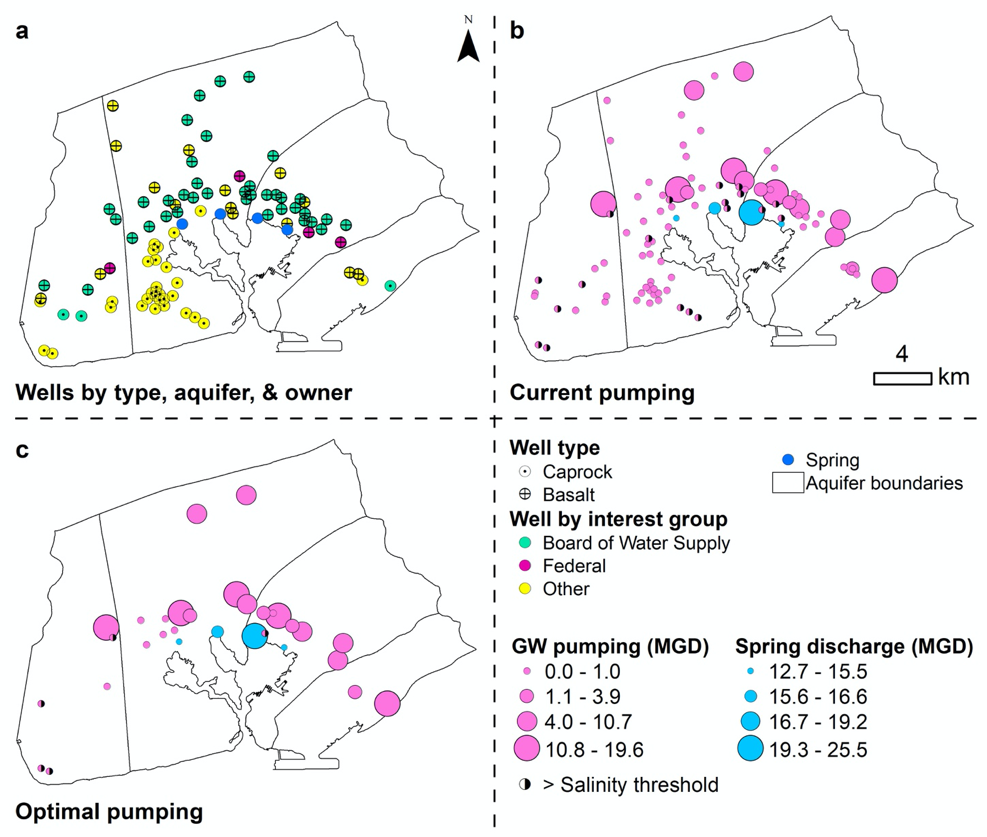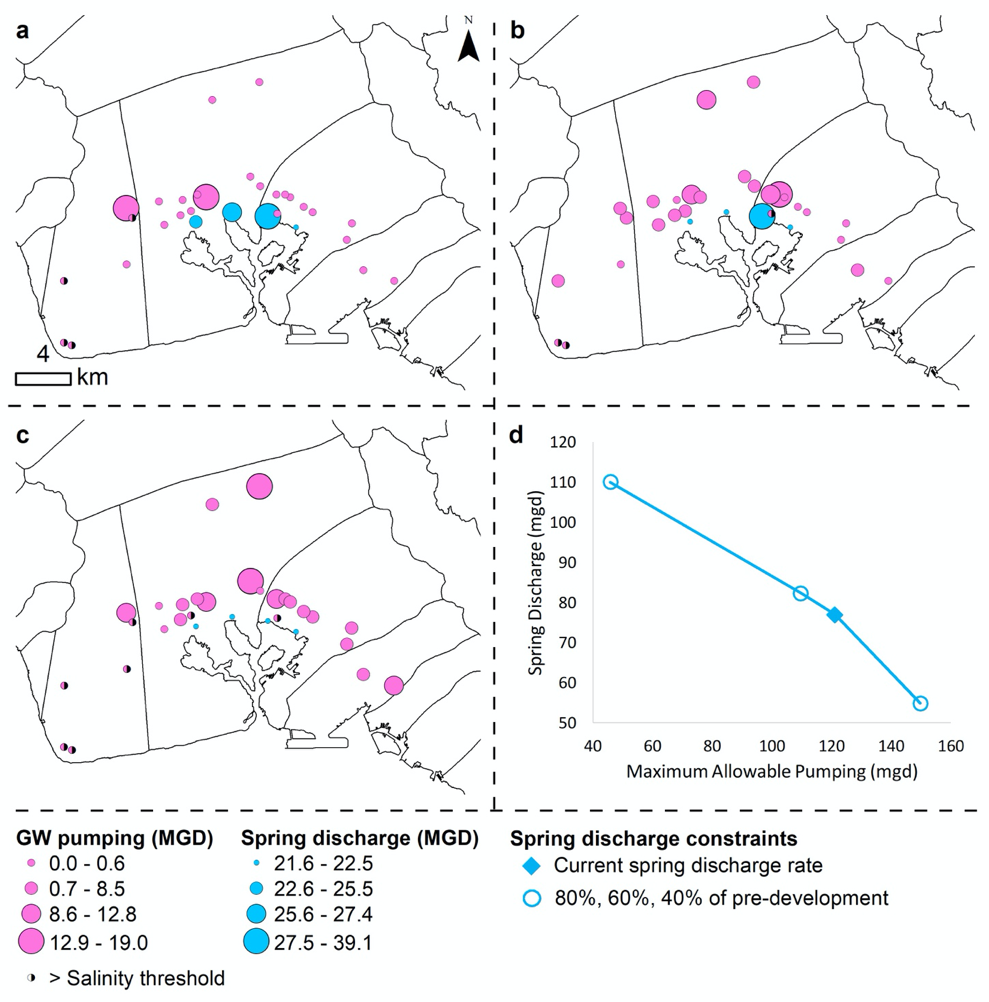BLOG POSTS ARE PRELIMINARY MATERIALS CIRCULATED TO STIMULATE DISCUSSION AND CRITICAL COMMENT. THE VIEWS EXPRESSED ARE THOSE OF THE INDIVIDUAL AUTHORS. WHILE BLOG POSTS BENEFIT FROM ACTIVE UHERO DISCUSSION, THEY HAVE NOT UNDERGONE FORMAL ACADEMIC PEER REVIEW.
By Kimberly Burnett, Ahmed Elshall, Christopher Wada, Aida Arik, Aly El-Kadi, Clifford Voss, Jade Delevaux, and Leah Bremer
The value of considering a range of diverse benefits is particularly salient in geographically isolated areas like the Hawaiian Islands, where judicious management of limited local freshwater resources is essential to sustaining the wellbeing of residents and the health of linked ecosystems. Hawai‘i is heavily reliant on groundwater, and there is a long-standing concern about stress on the state’s groundwater resources. Management of the highly utilized Pearl Harbor aquifer on O‘ahu, in particular, requires consideration of multiple competing uses of water as it supports a large portion of the population of Honolulu, as well as the military, agricultural, and tourism sectors of the economy. To that end, UHERO researchers collaborated with a team of scientists on the NSF-funded ‘Ike Wai project to assess the trade-off between groundwater pumping and protecting the culturally and historically important spring system in Pearl Harbor aquifer.
Groundwater management in Hawai‘i operates under the State Water Code which specifies a number of protections under the public trust doctrine, including the maintenance of proper ecological balance as well as preservation and enhancement of waters for consumptive and recreational uses (HRS Chapter 174C 1987). We considered the protection of spring discharge to Sumida Farm, an ecologically, socially, and historically important ten-acre watercress (Nasturtium officinale) farm that is dependent on free-flowing water from Kalauao Spring for maintaining crop production. The farm is the only green space in the otherwise heavily urbanized Pearl City area and is the largest watercress producer in the state, delivering 4-5 tons per week to the O‘ahu market alone. Spring discharge at the farm has decreased by roughly 50% since the farm began in 1928, from 10 million gallons per day (MGD) to approximately 5 MGD by the 1990s, during which the Sumida family observed lower crop yields.
Using data provided to the Commission on Water Resource Management (CWRM) by well operators, we initially identified 98 pumping wells in the Pearl Harbor groundwater area (Fig. 1a). For both computational and practical reasons, the analyses were then restricted to 27 major wells with current pumping rates greater than or equal to 1 MGD. Pumping from wells currently pumping less than 1 MGD were held constant in all simulations. For the 50-year design period from 2021 to 2070, simulation optimization was used to estimate the maximum allowable pumping in the Pearl Harbor aquifer without violating salinity, water level drawdown, and spring discharge constraints. To better understand the tradeoff between spring discharge protection and pumping in particular, we ran the simulation optimization under four different scenarios regarding spring discharge: maintaining current spring discharge, and spring discharge constrained at 80%, 60%, and 40% of the pre-development level.

Our simulation optimization results suggest that over a 50-year period with salinity, drawdown, and current levels of spring discharge constraints, the optimal maximum allowable pumping is 127 MGD (Fig. 2d). For comparison, the current pumping rate of 117 MGD (Fig. 1b) is already near the estimated optimal maximum, while the current state-designated sustainable yield value of 182 MGD is notably higher. Maximum allowable pumping changes from 127 MGD to between 45-150 MGD, depending on the severity of the spring discharge constraint (Fig. 2). As the discharge constraint is relaxed (shifting from Fig. 2a to 2c), maximum allowable pumping rates increase and are more uniformly distributed across the aquifer.

Without reducing aboveground water consumption, restricting pumping to maintain a desired rate of spring discharge generally increases costs to other water users. With a constraint in place, a combination of behavioral, policy, and technological changes would be required to increase water use efficiency to some degree. Any remaining demand in excess of the maximum allowable pumping of groundwater would have to be met by an alternative, likely more expensive, water source. This would put upward pressure on water prices for all customers of the municipal water system, including domestic, commercial, industrial, and some agricultural users. At the same time, however, maintenance of spring discharge generates a number of benefits beyond those related to spring-dependent agriculture. Many coastal ecosystems, both terrestrial and marine, depend on groundwater discharge to some extent. Coral reef, algae, and fish health, for example, can be affected by changes in salinity or nutrient concentrations carried into the nearshore by groundwater. These ecosystem impacts can, in turn, affect social systems like commercial or subsistence fisheries and recreational activities for both residents and visitors.
Link to full paper: https://doi.org/10.3389/frwa.2020.00014